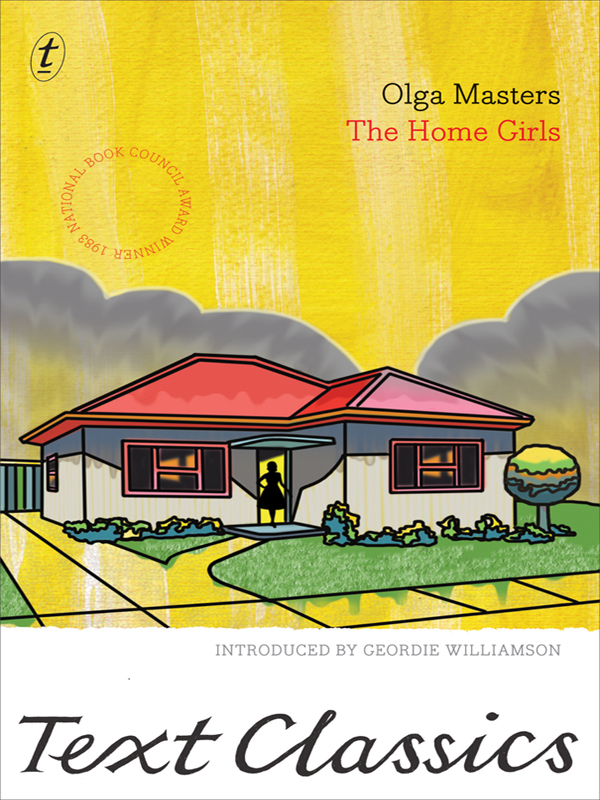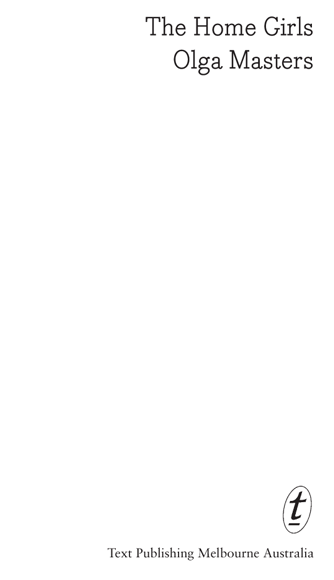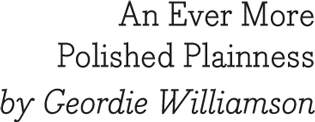The Home Girls


 Â
Â
Â
Â
Â
Â
Â
OLGA MASTERS
was born in Pambula, on the far south coast of New South Wales, in 1919. Her first job, at seventeen, was at a local newspaper, where the editor encouraged her writing. She married at twenty-one and had seven children, working part-time as a journalist for papers such as the
Sydney Morning Herald
, leaving her little oppor-tunity to develop her interest in writing fiction until she was in her fifties.
In the 1970s Masters wrote a radio play and a stage play, and between 1977 and 1981 she won a series of prizes for her short stories. Her debut collection,
The Home Girls
, won a National Book Council Award in 1983. It was followed by a novel,
Loving Daughters
, which was highly commended for the same award. Her next books, the linked stories
A Long Time Dying
and the novel
Amy's Children
, met with critical acclaim. This brief but highly prolific period ended when Masters died, following a short illness, in 1986. She had been at work on
The Rose Fancier
, a posthumously published collection of stories.
Reporting Home
, a selection of Masters' extensive journalism, was published in 1990. A street in Canberra bears her name.
GEORDIE WILLIAMSON
has been the
Australian
's chief literary critic since 2008. He won the 2011 Pascall Prize for criticism and his book
The Burning Library
will be published soon by Text.
ALSO BY OLGA MASTERS
Loving Daughters
A Long Time Dying
(stories)
Amy's Children
The Rose Fancier
(stories)
Non-fiction
Reporting Home
(ed. Deirdre Coleman)

Â
The Text Publishing Company
Swann House
22 William Street
Melbourne Victoria 3000
Australia
Copyright © the estate of Olga Masters 1982
Introduction copyright © Geordie Williamson 2012
All rights reserved. Without limiting the rights under copyright above, no part of this publication shall be reproduced, stored in or introduced into a retrieval system, or transmitted in any form or by any means (electronic, mechanical, photocopying, recording or otherwise), without the prior permission of both the copyright owner and the publisher of this book.
First published by University of Queensland Press 1982
This edition published by The Text Publishing Company 2012
Some of these stories have been published before: âCall Me Pinkie' and âAdams and Barker' in the
Sydney Morning Herald
; âA Young Man's Fancy' in
Stories of Her Life
, ed. Sandra Zurbo (Outback Press, 1979); âA Good Marriage' in
South Pacific Stories
, ed. Chris and Helen Tiffin (South Pacific Association for Commonwealth Literature and Language Studies, 1980); âYou'll Like It There' has been broadcast by Radio 5UV Adelaide.
Cover design by WH Chong
Page design by Text
Typeset by Midland Typesetters
Printed in Australia by Griffin Press, an Accredited ISO AS/NZS 14001:2004
Environmental Management System printer
Primary print ISBN: 9781922079466
Ebook ISBN: 9781921961748
Author: Masters, Olga, 1919-1986.
Title: The home girls / Olga Masters ; introduction by Geordie Williamson.
Series: Text classics.
Other Authors/Contributors: Williamson, Geordie.
Dewey Number: A823.3
eBook production by
Midland Typesetters
, Australia
Â
CONTENTS
Â
An Ever More Polished Plainness
by Geordie Williamson
Â
Â

Â
IF you know one thing about Olga Masters it will likely be that her first book, a collection of short stories called
The Home Girls
, was published when she was sixty-three. Her literary career lasted just six years after that, concluding with an unfinished collection of short fiction,
The Rose Fancier
, published two years after her death in 1986 from a brain tumour. Two novels, a play, a radio drama and fifty-four stories, many of which are no longer than a few pages, comprise almost all of Masters' output. On this slender body of work hangs one of the truly substantial reputations in contemporary Australian literature.
Les Murray was among the first to note the special quality of her fiction. He encouraged her to submit two early stories to the
Sydney Morning Herald
in 1979, one of which, âCall Me Pinkie', was published in the paper. After Masters shared a major short-story prize in 1980 with Elizabeth Jolley the University of Queensland Press, publishers of Peter Carey and David Malouf, commissioned her first collection and went on to publish all her work. Critics, academics and fellow writers were unstinting in their praise. It was a matter for general wonder that a writer of such gifts should have chosen to raise a large family before starting to write.
As always, the truth is more complicated. Masters, who was born in 1919 and raised on the New South Wales south coast, actually published her first two stories in 1934. They appeared in the
Cobargo Chronicle
, a local newspaper where Masters worked briefly as a gopher during the worst years of the Depression, until the editor was unable to meet even the modest cost of keeping her on. Slight and derivative though they were, the pieces were remarkable efforts for a girl whose formal education ceased at fifteen, and who was the second of eight children from an impoverished rural household. In her 1991 biography of the writer, Julie Lewis reports that Masters' reading material during those years was the newssheets used to wrap the groceries.
Nor did Masters wait for her family to grow up before returning to writing. She was thirty-five, the wife of a country headmaster and a mother of six when domestic life and small-town society got the better of her, and she returned to journalism. Working as a stringer for various local papers she covered weddings and tea parties, concerts and school news: the women's round. This was the beginning of a long apprenticeship in drawing narrative sustenance from niggardly stores. As Masters explained in a 1986 interview with Jennifer Ellison: âI learned a lot about human nature, and human behaviour, as a journalist. I worked on small papers and you'd go out for a story and it wouldn't be much of a story, but you'd make it into a story. The lesson there was that there is more in life, more in situations, than meets the eye. The deeper you dig, the more you find.'
This, too, is the collective lesson of Olga Masters' fiction. Her short stories and novels suggest that passion or violence need not be external, a matter of the public or political, but may be internalised insteadâlodged deep within the human heart. Her fictions seem so humble in conception, so soothing in domestic scope, that their ferocity comes as a shock. The classical order of Masters' literary forms and the tidy language she employs don't disguise the potential for anarchy in ordinary life; instead, they clarify its possibility, just as the neatness of an obsessive-compulsive admits the disorder to which objects are prone.
Masters' fictions are mostly set far from the flourishing present: on hardscrabble smallholdings and pastoral concerns, in village cottages and inner-city terraces. They take as their background the Great War's aftermath, the biting Depression years, the vast disruptions of World War II and the creeping modernity that followed in its wake. They span an era in which poverty or loss deforms the lives of individuals, families and entire communities; when isolation, both literal and psychological, can be so total as to turn those who suffer its effects into fantasists and schizoids. In this world, men's unwillingness or inability to communicate is a perquisite of gender, and women variously exhibit what a philosopher once called âthe terrible power of the oppressed'. Here children, cast early into adult responsibility, seem closer to vassals than daughters or sons.
Yet, for all the unspoken misery of their inner lives, the rigid roles and petty strictures that govern their days, Masters' characters have authentic relations with all around them. Their engagement with reality is unmediated by pop psychology or mass media. It has a purity that bathes even the worst acts in an innocent light. To recognise this aspect of Masters' vision is not to engage in nostalgia for lost virtuesâthough the men and women she describes have all but passed from the typology of Australian selvesârather, it is to accept the narrow and superannuated character of her creations as a necessary attribute of their enduring worth. The child of rural poverty raised in the 1920s and '30s in a distant corner of New South Wales, and the young woman who escaped to the city only to find herself pulled back to the bush as a wife and mother at the mercy of her husband's career, did as Chekhov instructed and passed judgement on what she knew best.
A single story from
The Home Girls
can serve as a fractal image of the larger patterns in Masters' work. âThe Rages of Mrs Torrens' is set in Tantelloââa town with a sawmill, some clusters of grey unpainted weatherboard cottages, a hall and the required number of shops for a population of two hundred'. The story blends aspects of her personal geography (the name of the town is a portmanteau of Tanto and Candelo, two south coast towns where she lived as a child, though the tale is actually set north of Sydney) and personal history (Mrs Torrens was partly modelled on a woman Masters knew). Masters' fiction often draws on real places, persons and events, but its focus is so tight that only the foreground remains in the pictureâreality becomes a blur at the edges of her art.
The narrative, which unfolds in the warm earth tones of extended anecdote, tells of a mill worker's wife whose temper is so intenseâvolcanically unpredictable and unusual in expressionâthat passing on her latest outrage has become the town's unofficial sport. There is the day that Mrs Torrens and a car filled with her thrilled and terrified children leap a partially repaired bridge, Dukes of Hazzard style. And there is the night when, for reasons unknown, she scatters two pounds of shilling pieces, her husband Harold's much-needed pay, into the icy creek behind their rented home.
While moods so extreme amount to a kind of social Tourette's, Masters does not describe them in clinical terms. From the outside (and we, as readers, often learn of events via the recycled rumours of the townsfolk), Mrs Torrens' anger could be mistaken for the protests of an independent and exuberantly sensual woman who finds herself trapped in the open-air confines of an Australian country town.
Crisis comes when Harold accidentally loses his right hand to a milling blade. Soon after, a still and erect Mrs Torrens appears at his workplace to confront the mill staff, who are visibly nervousâand with reason, as Mrs Torrens' reaction is to arm herself with a length of timber and lay waste to the office tea room, smashing china cups and sending the primus stove âlike a flaming ball bowling across the floor'.
But these violent acts are not what make the account so strange; it is what accompanies them. Masters lingers over Mrs Torrens' clothing, describing âa black dress with a scarf-like trimming from one shoulder trailing to her waist': âOn the end she had pinned clusters of red geraniums and on her head she wore a large brimmed black hat with more geraniums tucked into the band of faded ribbon. On her feet she wore old sandshoes with the laces gone.'
The ensemble's final effect may be eccentric, but it is not insane. There is a feminine challenge in this homemade glamour. In the moments before her vandal-ism Mrs Torrens clambers up a pile of sawn timber and onto a high fence, where she performs a defiant dance above the assembled eyes of the men. âWhat have you done with my beautiful, beautiful manikin?' is her sing-song question, addressed to everyone and no one. They are the only words she utters throughout.
In days to come the dance will prove more troubling to those mill workers than any broken china: âSome repeated her words but kept them inside their throats in the darkness of their bedrooms and seizing their wives for lovemaking held onto the vision of Mrs Torrens with her still face under her black hat and her strong thighs moving under her black dress as she walked the fence.'
The ârage that ended all the rages of Mrs Torrens in Tantello' is not the story's conclusion. We learn of the family's subsequent flight to the city and the adult Torrens' years of working together as cleanersâshe his literal right handâof the final taming of her temper with the aid of medication, and of her death, in her fifties, from a heart attack. The story ends with her daughter Aileen, now a successful clothes designer (her mother's sartorial extravagance normalised into an occupation), passing through Tantello on a whim during her honeymoon and stopping by her former home, which has fallen into ruin.
In its folkloric dramatisation of small-town comm-unity, its celebration of the power of female sexuality and its nursery-rhyme rhythms, âThe Rages of Mrs Torrens' is extraordinary. The rapid movement of the tale subverts its realism, while the minimal punctuation common to all Masters' early stories lends artlessness to what is an otherwise tightly composed work.
Toughness, humour, irony, sympathy for outsiders, as well as for mothers and daughters: these are the base elements of Olga Masters' fiction. And in the few years left to her after
The Home Girls
Masters worked tirelessly to refine them, eventually achieving a style as straightforward as her psychology was complex. Her curious achievement was an ever more polished plainness: a simplicity of tone that honoured the modesty of the subjects it described.
When Masters died, in September 1986, she was still working on her final short-story collection,
The Rose Fancier
. The title story is the last in the volume, as the author intended, and it is one of eight to exist in a final-draft state. In it a country solicitor of the Edwardian era sets aside a quarter-acre of his garden for roses, and as the bushes grow and spread he removes the stakes that hold them. As a valedictory emblem for Masters' stories they are marvellously apt: all issue from the same dark soil of the author's experience but burgeon in the many colours of her imagination. Readers should beware, however: hidden in the beauty of their telling are points that wound; there are real thorns in her imaginary gardens.
